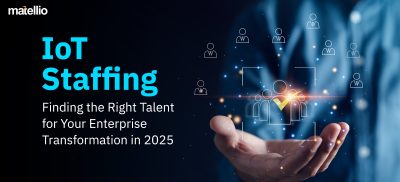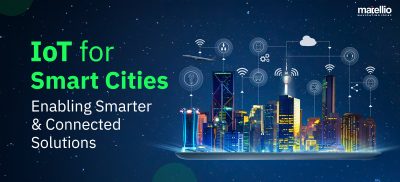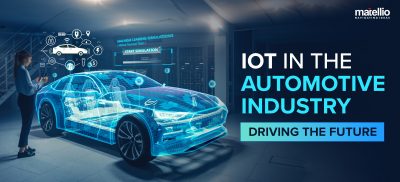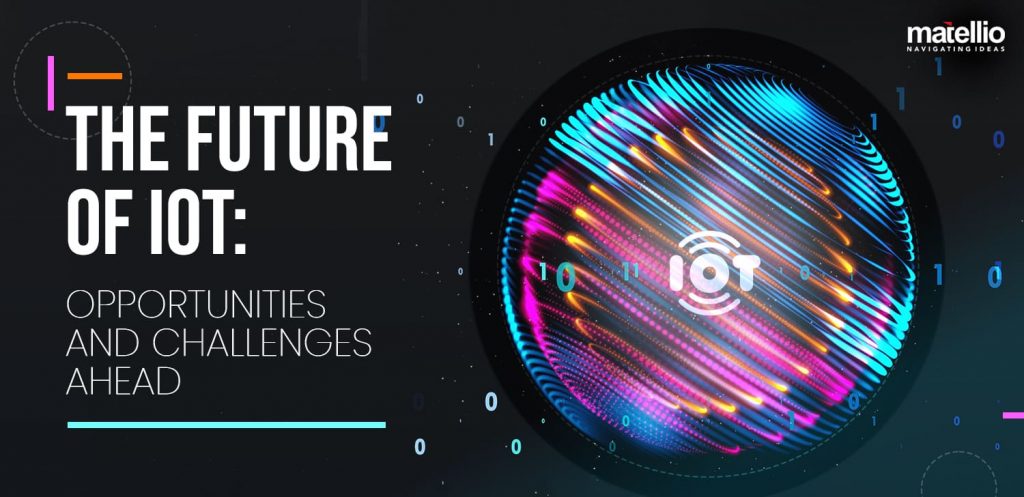
The Internet of Things (IoT) is revolutionizing the way businesses and, in turn, the world operates. It is transforming the landscape for various industries across the globe. Be it mass production sectors like agriculture and manufacturing or verticals with very specific demands and requirements like healthcare and education, IoT is revolutionizing them all at a blinding pace. In fact, as per the latest insight revealed by Statista, the number of IoT devices across all industries is forecasted to grow to over 8 billion by 2030, with a CAGR of 72%! With such a huge growth curve, IoT is all set to change the way we interact with the world around us and in this post, we’re exploring some of the major ways it’ll do so in different verticals.
What is the Future of IoT and What Opportunities Does It Hold for Different Sectors
The pace with which the IoT market is growing makes it apparent that the future trends of IoT are going to disrupt all the major industries in the near future. In this section, we will uncover the current status and future prospect of IoT, and see what exciting growth opportunities future of IoT present to businesses across different verticals.
Future of IoT in Energy Sector

The future applications of IoT has the potential to completely transform the way the energy sector is managed today. With the ability to connect and monitor devices and through them their energy consumption, IoT can streamline the calculation of utility charges and bring more transparency to the entire system. This enhanced visibility and control of energy systems can also lead to improvements in resource optimization and, consequently, cost savings. Some of the other revolutions IoT has in store for the energy industry.
Smart Grid
In future, IoT can help create a more efficient and automated smart grid system for monitoring, analyzing, and controlling energy usage and production. This can help improve energy efficiency and reduce costs associated with energy production and consumption. The data collected through these smart grids can also be used to better understand energy usage patterns and optimize energy production and distribution.
Predictive Maintenance
By using IoT devices such as sensors and cameras, energy companies can monitor the condition of their assets in real-time and detect potential problems before they become critical. This can enable them to plan maintenance schedules, optimize operations and reduce unplanned downtime.
Renewable Energy
Connected smart sensors in an IoT network can be used to monitor the output from various renewable sources. This can help in assessing the efficiency of the systems that store and distribute the energy for more efficient and cost-effective use of renewable energy. IoT-enabled systems can also gather more detailed insight into real-time consumption patterns, which can further be used to better plan and manage the distribution of renewable energy sources, such as wind and solar, to ensure they are used most efficiently.
Efficient Consumption
Optimizing energy consumption is crucial for the sector since they are already struggling with the growing demand of electricity. As such future of IoT can prove to be a game changer for all their new initiatives in the regards. Smart energy meters can detect energy usage and send the data to a central monitoring system to identify areas of energy wastage and suggest ways to optimize energy consumption. Similarly, smart thermostats can also be used to reduce energy consumption by automatically adjusting the temperature of a room based on user preferences and usage patterns.
Also Read: Top IoT Solutions for Energy and Utilities
Future of IoT in Manufacturing
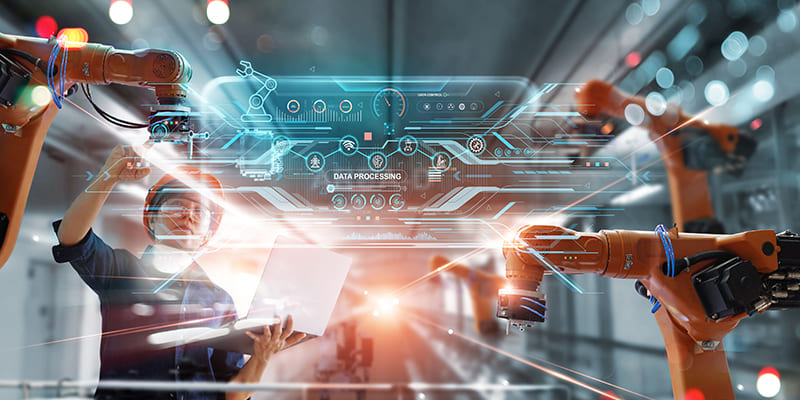
With connected smart sensors, equipment, and other future applications of IoT, manufacturing companies can collect data about production operations and use it to optimize processes and operations. As such, the future of IoT carries the potential to improve production efficiency and quality, reduce costs, and improve safety in the manufacturing environment. It also allows for greater visibility into production processes and more effective decision-making.
Predictive Maintenance
Predictive maintenance is a key application of IoT in manufacturing. It involves collecting and analyzing data from manufacturing equipment to predict when maintenance will be needed before a breakdown occurs. This further helps in reducing downtime and ensuring continuous production and supply. Predictive maintenance applications can also be used to identify potential problems early stages. This way, manufacturers can take action to improve equipment performance and extend its lifespan. Other than these two major benefits, IoT-enabled maintenance procedures also tend to reduce maintenance costs and improve workplace safety.
Real-time tracking and monitoring
Implementing IoT in manufacturing plants will enable administrators to track and monitor their operations in real time. By connecting machines and other devices to a central system, manufacturers can capture and analyze data in order to gain insights into production processes, identify inefficiencies, and make better decisions. For example, IoT-enabled sensors can be used to measure various manufacturing parameters such as temperature, pressure, vibration, and energy usage. This data can then be used to optimize production processes, detect anomalies, and reduce downtime.
Quality control
The future applications of IoT in Manufacturing can also be used to improve quality control procedures. The plant can be equipped with thermal sensors and intelligent cameras with automatic 3D image evaluation. They can then monitor production processes, allowing for real-time data collection and analysis. This way, they can detect defects and take remedial actions to help the final product meet the quality standards. IoT can also be used to improve the traceability of products’ lifecycles, from raw materials to finished goods. This will help in reducing the risk of product recalls and improve production efficiency.
Remote Monitoring and Control
IoT-enabled remote monitoring and control can improve production efficiency, reduce maintenance costs, and improve quality control. These systems can be used to monitor machine performance, temperatures, pressures, and other process conditions in real-time so the operator can control machine and its various parameters by making better-informed decisions.
Also Read: How Does IoT Development Lead to Advance Benefits for the Manufacturing Industry?
Future of IoT in Agriculture
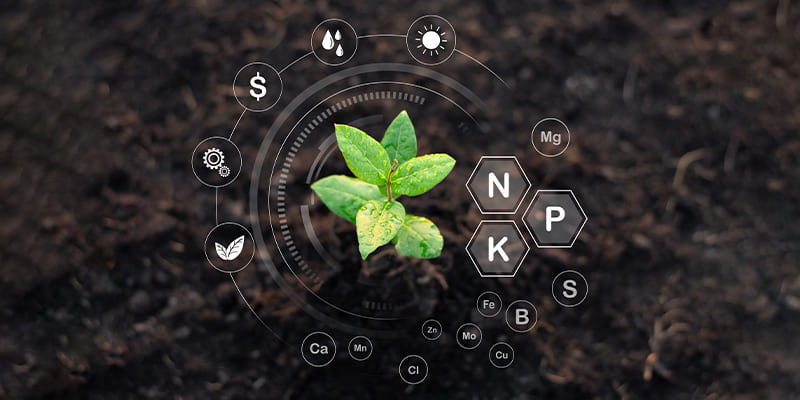
IoT in Agriculture can be used to collect data from sensors, drones, and other sources, to bring efficiency in crop management, soil and cultivation health monitoring. The technology can also be used to automate processes such as irrigation, fertilization, and pest control. Some specific opportunities with the future of IoT in agriculture include-
Precision Farming
IoT devices can monitor, collect and analyze data from farming operations. You can hire an IoT development company to build you sensors and devices and integrate them too with centralized software. There you can monitor soil moisture, temperature, light, wind, and other environmental conditions, as well as equipment such as tractors, harvesters, sprayers, and other farm machinery. This data can be used to create more accurate and efficient precision farming techniques, which in turn will help farmers reduce water and fertilizer use, increase crop yields and improve the quality of their products.
Smart Irrigation
Smart irrigation systems powered by IoT can use sensors and data to monitor soil moisture levels and automatically adjust watering schedules to match the needs of the plants. This automated system helps farmers reduce water waste and conserve resources while also providing plants with the optimal amount of water to help them grow healthy and strong. Smart irrigation systems can further be used to track water usage and detect any potential problems, such as leaks or low-pressure zones. This can help farmers save time and money by preventing costly repairs.
Livestock Monitoring
The future of IoT in agriculture can efficiate livestock monitoring systems to help farmers track the health and behavior of their animals in real time. This allows them to detect problems early on and take preventive measures, as well as to monitor animal performance and ensure that they are on track with their growth and development. This helps them to maximize the well-being of their animals and improve the overall productivity of their farms.
Remote Monitoring and Control
With smart remote monitoring systems, IoT will help agricultural professionals collect data from their fields in real time and act upon it quickly. They can monitor and control soil moisture, temperature, and water levels, as well as track the growth of crops and animals. They can also detect diseases, pests, and other problems in a field. This helps farmers to adjust their cultivation practices accordingly and in a timely manner while handling things remotely. This will help them make better-informed decisions and reduce a good amount of fortune on labor costs.
Climate Control
IoT-enabled climate control systems can help farmers better manage their crops by providing data on soil moisture, temperature, wind speed, and other environmental factors. This data can then be used to optimize irrigation and other crop management practices, helping farmers reduce their utility and material costs and improve their yields. By using predictive analytics, farmers can also anticipate and prepare for extreme weather events.
Sustainable Farming
IoT is among the only few technologies that can actually be used to improve the sustainability of farming practices. For example, sensors can be used to monitor soil conditions, moisture levels, and weather conditions. This data can be used to automate irrigation systems and adjust fertilizer levels accordingly. IoT-enabled drones can monitor crop health and take aerial photos for better crop management decisions. IoT-connected devices can also be used to improve communication between farmers, distributors, and consumers to create an overall more sustainable and efficient agriculture industry.
Future of IoT in Retail
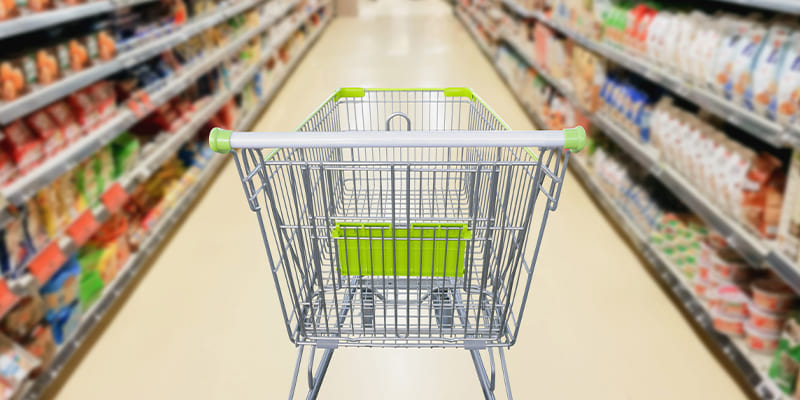
Among other technologies, the future of IoT solution , too, is contributing to the seismic shift of the retail revolution. From providing retailers with unprecedented opportunities to improving customer experience, IoT has the most promise in increasing the net revenue for retail businesses exponentially. The technology is already helping retailers in collecting data on customer preferences and trends to provide personalized experiences, streamline the supply chain, and automate inventory management. In the near future, it will also use IoT retail solutions like facial recognition, smart shelves, and intelligent pricing to make decisions based on real-time data.
Inventory Management
IoT in retail applications is already being used to help businesses manage their inventory more efficiently. In the future, IoT sensors will be able to track the exact location of products in the store, alerting retailers when stock levels are running low and when products need to be restocked. IoT can also be used to track customer behavior in the store, helping retailers better understand their customers and identify future trends to manage their inventory proactively.
Smart Shelves and Displays
Smart shelves and displays are among the most exciting IoT opportunities for retail businesses. They can provide customers with real-time product availability and pricing, as well as product recommendations. These placements can also help businesses collect data on customer behavior and preferences, which can, in turn, be used to tailor marketing campaigns and promotions. With the increasing use of artificial intelligence, retailers can also utilize smart shelves to provide personalized shopping experiences.
Personalized Marketing
As future applications of IoT continue to evolve, retailers will be able to deliver more personalized experiences to their customers. For example, IoT-enabled devices can track customers’ shopping habits to tailor marketing messages and promotions in real-time. Using the same data, retailers can also provide tailored product recommendations, discounts, and special offers to customers, helping them increase their conversion rates and improve customer experience and loyalty.
Smart–fitting Rooms
Smart fitting rooms, powered by IoT, will enable customers to try on clothes using a virtual mirror. The rooms will be equipped with sensors and cameras, and the virtual mirror with the inventory and interactive software of the retail brand. Together they will allow customers to quickly and accurately try on clothes and get the accurate size and fit without having to actually wear different items. These smart fitting rooms can also become another outlet for businesses to provide customers with personalized recommendations and discounts, further enhancing the customer experience and the average order value per customer.
Mobile Payments
With the rise of mobile phones and the increasing prevalence of internet-connected devices, the use of mobile payments in retail is becoming commonplace. This means that retailers are able to offer customers more convenient, secure, and personalized payment options while also reducing the amount of time and effort associated with processing payments.
In-store Analytics
IoT devices such as Bluetooth beacons, sensors, and RFID tags can track customer movement and behavior in stores, allowing retailers to gain better insights into their customers and how they interact with their stores, shelves, and aisles. This data can be used to create more personalized marketing campaigns and store layouts, as well as to better understand customer preferences and trends. IoT can also help retailers better manage their inventory and operations, leading to improved efficiency and cost savings.
Smart Logistics
With IoT logistics solutions, retailers can facilitate the automation, tracking, and optimization of the entire supply chain process. They can use IoT to track inventory levels more accurately to make informed decisions about stock levels. The carriers can also monitor shipments and alert retailers if there are any delays or problems. This enables them to react quickly and resolve any issues before they have a negative impact on customer satisfaction.
Also Read: How Can IoT Improve the Retail Industry?
Future of IoT in Healthcare
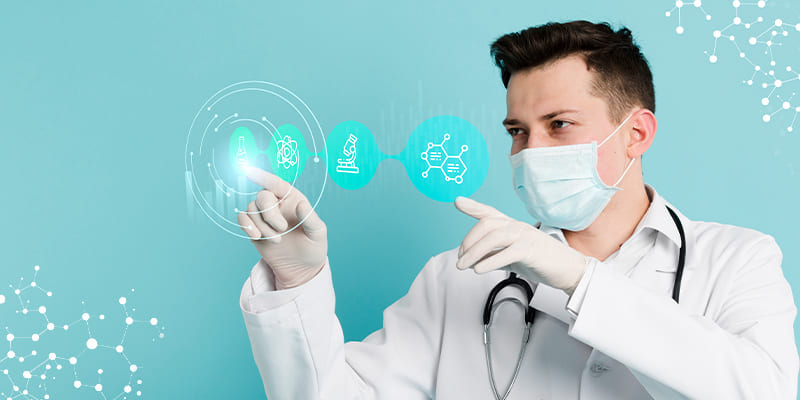
Among other sectors, IoT has the most impact on the future of the healthcare industry. The transformative technology has the potential to enable medical professionals to collect real-time data from remote patients, medical devices, and other sources. This data can then be analyzed to identify trends and predict outcomes.
Remote Patient Monitoring
With the use of IoT-enabled devices like smartwatches and glucometers, healthcare providers will be able to monitor a patient’s vital signs and health status in real time. This will enable them to provide timely and effective treatment and feedback to the patient. These devices can be used to monitor a patient’s lifestyle habits, such as their diet and exercise routine, allowing for more personalized care. Furthermore, future of IoT in healthcare can be used to improve the accuracy and reliability of medical diagnoses and the effectiveness of different medical treatments without having to keep patients under strict observation.
Smart Hospitals
With the help of IoT, hospitals can become smarter and automate the collection and analysis of data from medical devices, patients, and staff. This will help them gain real-time insights into the overall functioning of the hospital. This data can then be used to make better decisions, improve the efficiency of processes, and deliver more personalized care. As hospitals become more connected through specialized IoT healthcare solutions, they will be able to offer more advanced patient care and improved operational efficiency.
Telemedicine
The solutions in future of IoT in healthcare will enable medical professionals to access and monitor patient data from anywhere in the world. This will allow for real-time diagnosis and treatment, as well as remote monitoring of patients. AI-powered analytics could also be used to enable predictive and preventive healthcare. Together, both technologies will enable medical devices to remain connected to the internet, allowing for remote access to medical records, remote monitoring, and remote healthcare delivery. This will greatly enhance the efficiency of healthcare delivery while also reducing costs.
Medication Management
IoT-enabled medication management systems can help to improve the accuracy, speed, and efficiency of medication delivery. These systems can be used to track and monitor the usage of medications, alert caregivers when medications are due, remind patients to take their medicines, and provide real-time feedback on medication adherence. As such, they can help reduce medication errors, improve patient safety, and reduce healthcare costs.
Clinical Decision Support
By harnessing the power of future of IoT in healthcare, medical professional will gain a better understanding of patient’s health data, leading to more informed decisions for diagnosis, treatment, and prevention. This, in turn, can lead to improved outcomes for patients and better resource utilization for providers. One way that IoT can get used to supporting clinical decision-making is through predictive analytics. By analyzing patient data collected from connected devices, healthcare providers can detect patterns that may indicate a potential health risk or a need for more intensive care. This information can then be used to inform treatment plans and help healthcare providers make decisions that are tailored to the individual.
Medical Equipment Management
Connected medical equipment is easy to track and manage remotely. With smart sensors assessing every part of the equipment, it becomes easy to monitor their performance and ensure that they are in the best working condition possible. This can lead to increased patient safety and improved patient care. IoT can also automate the process of ordering and restocking medical supplies and equipment, ensuring that healthcare providers never run out of them.
Also Read: IoT Healthcare App Development and Solutions: A Comprehensive Guide
Future of IoT in Real Estate

IoT is rapidly transforming the real estate industry, making it easier than ever for property owners, managers, and tenants to monitor, manage, and automate utility consumption and payment on their properties. By leveraging the power of IoT technology, the real estate sector can benefit from increased efficiency, security, and convenience. In the future, IoT will enable real estate stakeholders to access real-time data, automate processes, and create a seamless experience for all involved.
Smart Buildings
Smart buildings are becoming increasingly popular use cases of IoT in real estate. They are equipped with sensors and connected devices that enable a wide range of automated processes, such as lighting, temperature control, and security. In addition, they can provide tenants with access to real-time data about their environment, allowing them to make informed decisions about their energy consumption and comfort levels. Smart buildings can also help landlords manage their properties more efficiently, as IoT devices enable them to track usage and performance data, reducing their costs and ensuring that the building is running at optimal efficiency.
Predictive Maintenance
Predictive maintenance is one exciting application of IoT in real estate that can be used to measure, monitor, and analyze the performance of buildings. This can help property owners predict and prevent breakdowns and reduce maintenance costs. IoT-powered predictive maintenance can be used to detect problems like failing equipment or inefficient HVAC systems in real-time, allowing property owners to take proactive steps to address them.
Smart Meters
Smart meters are becoming increasingly popular in real estate as they allow property owners to monitor and track energy usage. In the future, they would also come with features like automated billing and the ability to control appliances remotely. They could allow for dynamic pricing of utilities, enabling real estate owners to charge tenants based on how much energy they are using at any given time.
Tenant Engagement
With tenant engagement, landlords can provide advanced amenities to improve the tenant experience. Examples include managing energy and water usage, providing access to property services, providing real-time communication with tenants, and offering personalized offers. IoT can also provide data to help landlords make decisions about maintenance, security, and tenant satisfaction.
Smart Parking
Smart parking solutions are one of the most popular applications of IoT in real estate. They integrate sensors, connected devices, and analytics to provide parking solutions that are cost-effective, efficient, and secure. In the near future, they can also allow for automated payment systems, provide real-time parking availability information, and even enable users to book and reserve parking spots in advance.
Real-estate Analytics
IoT will enable real estate owners and managers to track property performance in real-time and make informed decisions quickly. Real-time analytics and data will provide insight into tenant usage, energy efficiency, and even occupancy trends. In addition, IoT can also be used to detect unauthorized access, detect water and gas leaks, and monitor the environment around the property. This will enable real estate managers to optimize their operations and save money. IoT in real estate analytics could also be used to predict future trends, such as housing prices, rental rates, and even crime rates.
Also Read: Impact of IoT in Real Estate
Future of IoT in Logistics
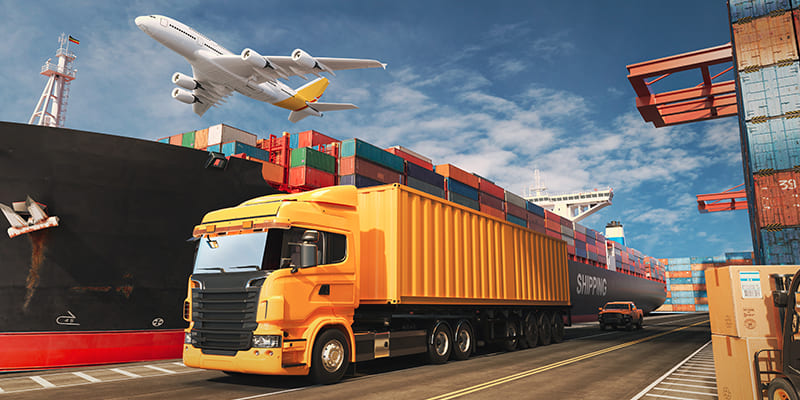
For transportation and logistics companies, IoT can help with better monitoring and management of supply chains and efficiating transportation through automotive IoT solutions. IoT-based systems can help reduce costs, improve efficiency, and create more customer-centric experiences. They can also be used to create predictive models and monitor the performance of assets, allowing companies to anticipate and respond to changes in demand quickly. With the increased use of IoT in logistics, companies will have increased visibility of their supply chains.
Real-time Tracking and Monitoring
Real-time tracking using devices like RFID tags, sensors, etc., can help in monitoring the location and condition of shipments throughout the supply chain. This information can then be used to optimize delivery routes and improve supply chain efficiency. IoT applications in logistics can also automate processes such as order fulfillment, status tracking, and inventory management. This increased visibility and data can also help logistics companies make more informed decisions, leading to greater cost savings and an improved customer experience.
Predictive Maintenance
Predictive maintenance is one of the most promising applications of IoT in the logistics industry. It allows companies to identify potential problems before they occur, reducing downtime and helping them to optimize their operations. Predictive maintenance can help companies track the performance of their assets, including vehicles, containers, and storage systems, allowing them to better understand how their resources are being used and helping them to make better decisions about their operations.
Smart Logistics
Smart logistics is another exciting use case of IoT that will provide more efficient and cost-effective solutions to a wide range of complex problems in the industry. It can be used to optimize the entire supply chain, from transportation to warehouse management. With real-time data collection and analysis, automated tracking, and predictive analytics, such solutions can help optimize the entire logistics process and reduce the cost of the operation. They will also empower companies to better manage their inventory, monitor the condition of goods, and reduce the risk of theft.
Fleet Management
By leveraging cloud-based data, predictive analytics, and vehicle-to-vehicle and vehicle-to-infrastructure communication, IoT-enabled fleet management solutions can provide managers with all the information they need to optimize fleet performance. For example, the system can help them track vehicle performance and maintenance, provide the real-time driver and vehicle data, and enable automated route optimization. In turn, managers can use this data to develop more efficient driving patterns, identify fuel savings opportunities, and improve customer service.
Also Read- IoT Fleet Management: Use Cases, Benefits and Features
Smart Warehousing
IoT-driven smart warehousing solutions will enable companies to collect, analyze and act on data in real-time, resulting in more efficient operations and improved customer service. They can be used to automate warehouse operations, reduce manual labor costs, optimize order fulfillment, and provide real-time insight into inventory levels. Automated systems can also be used to track items entering and leaving the warehouse, identify bottlenecks in the system, and manage stock levels.
Automatic Identification and Data Capture (AIDC)
AIDC technologies, such as RFID tags, barcodes, and GPS tracking, enable companies to streamline their operations, increase efficiency and reap all the other benefits of the future of IoT. IoT sensors can provide companies with real-time monitoring of assets, locations, and conditions. This data can be used to make better decisions, automate tasks, and improve customer service. With the emergence of 5G networks, IoT technology will become more ubiquitous and will have an even greater impact on logistics businesses. Companies that embrace AIDC technologies can expect to unlock increased efficiency, reduce costs, and improve customer service, as the technologies facilitating IoT solutions continue to evolve.
Environmental Monitoring
IoT solutions for logistics can enable companies to collect and analyze data in real time, giving them insights into the environmental conditions of their supply chain. This data can be used to optimize transportation routes, ensure that products are stored and shipped in an optimal manner, and reduce waste and costs. Companies can also use this data to make informed decisions about the environmental impact of their operations and to identify and mitigate potential environmental risks.
Future of IoT in Education

The education system has long suffered from a lack of innovation and contemporary methods. But today, thanks to initiatives like eLearning and AI-based gamification, the sector is witnessing visible growth in its size and impact. However, when it comes to IoT, it has the potential to completely revolutionize the entire educational system and enable us to learn more efficiently, quickly, and effectively. Some of the interesting IoT solutions for education that facilitate all these benefits are-
Smart Classrooms
Smart classrooms are classrooms that are equipped with digital technologies, such as interactive whiteboards, computers, tablets, and other digital tools, to facilitate teaching and learning. They provide opportunities for teachers to create more engaging and interactive lessons. With the rise of the Internet of Things (IoT), smart classrooms are becoming increasingly connected, automated, and inclusive. IoT enables the collection of data from various sources and devices, which can be used for various educational purposes, such as real-time student assessment and personalized learning. IoT can be used to create a connected learning environment where students and teachers can interact with each other, collaborate, and access content and resources more easily. This can also be used to improve student engagement and motivation, as well as to measure student performance in real time.
Personalized Learning
With the help of IoT, the education sector can become more personalized, efficient, and cost-effective. IoT-enabled devices can be used to monitor, collect, and analyze data from various sources. This data can be used to create personalized learning experiences for students and teachers. For example, an IoT-based education environment can monitor students’ progress and various impetuses that affect them. Thereafter, the system can provide them with the necessary guidance to improve their performance by constantly monitoring the effectiveness of their guidance.
Remote Learning
One of the most exciting opportunities that the future of IoT presents for education is the potential for remote learning. With the help of IoT-enabled devices, such as connected laptops and tablets, students can access course materials and engage with teachers and peers from virtually any location. This could benefit both students and educators, providing them with more flexibility and control over their learning experience. With IoT, educators could also monitor student engagement in real-time, providing personalized feedback and support as needed. Remote learning can also open up new opportunities for collaboration, as students from different parts of the world could come together to share ideas and collaborate on projects.
Smart Libraries
Smart libraries are becoming an increasingly popular concept in educational institutions. They can be built to use the power of IoT to automate library operations and provide students and faculty with a more convenient and efficient library experience. With smart libraries, books can be checked out and returned automatically, library patrons can access digital resources and information, and library staff can track library usage and book inventory in real time. For ancient manuscripts and other fragile books, smart libraries can use IoT sensors to monitor the environment and ensure that the temperature and humidity levels remain optimal for preserving the books.
Smart Security
An IoT-enabled smart security system for educational institutions can provide real-time security monitoring, alerting, and response. It can be used to detect intrusions, monitor student activity, and detect and deter potential threats. It can also be used to monitor the environment for hazardous conditions and equipment and alert the appropriate personnel to take corrective quickly. IoT can also be used to automate access control systems, allowing for better control and tracking of who enters and exits the premises and restricted areas such as laboratories and classrooms.
Attendance Tracking
IoT devices such as RFID tags and wearables can be used to quickly and accurately track attendance in a classroom. By using these devices, teachers can bring the future of IoT to life in education institutes and get real-time information about who is in the classroom and who is not, allowing them to quickly address any attendance issues. These devices can be used to track student progress and provide personalized learning experiences. Finally, IoT can be used to automate administrative tasks, such as taking attendance and submitting grades, freeing up teachers to focus on teaching.
Future of IoT in Travel and Hospitality

With the help of IoT in hospitality solutions hotels and travel agencies are able to offer a more personalized experience for their guests. IoT devices and applications can be used to automatically adjust lighting, temperature, and other environmental factors to create a more comfortable environment for guests. The technology can also be used to monitor customer preferences, provide real-time feedback, and optimize services to better meet customers’ needs
Smart Hotels
Smart hotels are futuristic hospitality areas that offer a range of connected services that can significantly improve the customer experience. These futuristic IoT solutions include automated check-in and check-out processes, interactive lobby displays, automatic room climate control, automated room service delivery, automated payment systems, and more. Guests can also control lights, curtains, and other in-room devices via a connected app or voice command. Smart hotels also offer advanced security and safety features, such as facial recognition systems, access control, biometric authentication, etc.
Personalized Experiences
The hospitality and travel industries are increasingly leveraging the power of the future of IoT to improve the customer experience. With the use of technology, hospitality businesses can create personalized experiences, including seamless check-in and check-out processes, real-time updates on flight delays, and other travel-related information personalized as per individual preferences. Companies could also use IoT to provide automated room temperature control, as well as the automated ordering of food and drinks.
Energy Management
With the looming threat of energy resource depletion, more and more hospitality businesses are planning to become sustainable. As such, in the near future, the travel and hospitality sectors will be able to use IoT to optimize energy management in hotels, reducing costs and increasing sustainability. Hotels will be able to monitor the energy usage of individual rooms and adjust temperature settings to match occupancy, reducing energy costs. On the customer end, IoT can be used to provide travelers with personalized experiences in terms of temperature and lighting, making the entire sojourn more enjoyable and lucrative for all the parties involved.
Smart Concierge
The travel and hospitality industry is planning to leverage advanced technologies solutions in future of IoT to create a more personalized and efficient customer experience. One such example is a smart concierge service that can provide guests with a range of personalized services. The service will use IoT applications to facilitate automated check-in and check-out processes and personalized room preferences. IoT-enabled smart concierges can also provide guests with tailored recommendations for activities, dining, and attractions based on their individual preferences and interests.
Also Read: IoT Consulting Services: Everything You Need to Know
Challenges in Implementing IoT for Different Sectors

Implementing IoT in various sectors can present a number of challenges, including:
Security
One of the biggest challenges facing IoT is security. As more and more devices get connected to the internet, there is an increased risk of cyberattacks. This is particularly concerning in industries such as healthcare and transportation, where a security breach could have serious consequences. To address this, companies and governments will need to invest in stronger security measures and better cybersecurity infrastructure. Additionally, it’s important to make sure that devices are designed with security in mind from the start, and that they are regularly updated with security patches.
Interoperability
Interoperability is another major challenge in implementing the future of IoT for different sectors, as different systems and devices need to be able to communicate with each other in order to achieve the desired results. Without interoperability, it is difficult for different systems and devices to exchange data, resulting in an inefficient and unreliable IoT system. This is especially difficult to achieve since different sectors have different standards or protocols for data exchange, making it difficult for different systems to communicate with each other.
Data Privacy
As IoT devices collect and share data, there is a risk that this data could be used for nefarious purposes. This can include things like targeted advertising or even identity theft. To address this, companies will need to implement strict data privacy policies, and ensure that customers are aware of what data is being collected and how it will be used. The way data gets communicated between devices should also be handled with appropriate security protocols to ensure no breach remains possible.
Scalability
Scalability remains one of the biggest hurdles in realizing the future of IoT. For any IoT system to function seamlessly, a large amount of data needs to be collected and stored in order to provide meaningful analysis. This data must be continuously updated, which requires a high level of scalability in order to keep up with the growth of the data. Most devices used today for IoT implementation are not able to handle an increasing number of connections and traffic without compromising the security of the connection. As such, the complexity of this entire architecture and the current limitations of different components make it difficult to scale any IoT system.
Integration
The complexity of connecting multiple systems, devices, and services makes integration another major challenge in the implementation of IoT for various sectors. Creating a seamless IoT experience requires the use of various technologies and devices, such as sensors, networks, databases, and cloud computing. Integrating these components is not an easy task, especially when the requirements of each sector vary. The integration of these components gets further complicated by the fact that the technology is constantly evolving, and new standards and protocols are being developed. Furthermore, the integration of IoT with existing legacy systems causes the most difficulty due to the lack of integrable options available with older technologies.
Cost
In any case, IoT devices are expensive, and they require a large upfront investment. The cost of connecting these devices to the cloud, maintaining them, and managing the data produced by the devices, too, can add up quickly. The cost of training personnel to use the devices and the associated software can be significant as well. Last but not least, maintenance charges and other ongoing costs associated with maintaining the system, such as updating software, troubleshooting, and replacing devices, can eat up a substantial amount of your budget, making the entire operation too costly to remain ROI-positive.
Realize the Future of IoT for your Business with Matellio
Matellio is an experienced IoT development services and consulting company that helps organizations overcome the challenges of implementing IoT in various sectors. One of the main challenges of IoT implementation is security. Matellio helps organizations implement robust security measures to protect IoT devices and the data they collect from cyber threats. This includes encryption, firewalls, and other security protocols. Similarly, Matellio’s experts have both expertise and experience in integrating IoT devices from different manufacturers into existing systems and processes, ensuring seamless communication and data sharing.
Matellio also helps organizations ensure compliance with privacy regulations by implementing best practices for data management, storage, and sharing. As such, with all this experience the IoT developers at Matellio can help you overcome many of the critical challenges that along with the implementation of IoT for industrial purposes. All you have to do is simply fill up our request a quote form and book yourself a free 30-minute consultation with our experts. From there it will be there responsibility that your IoT project gets started and released on time.


